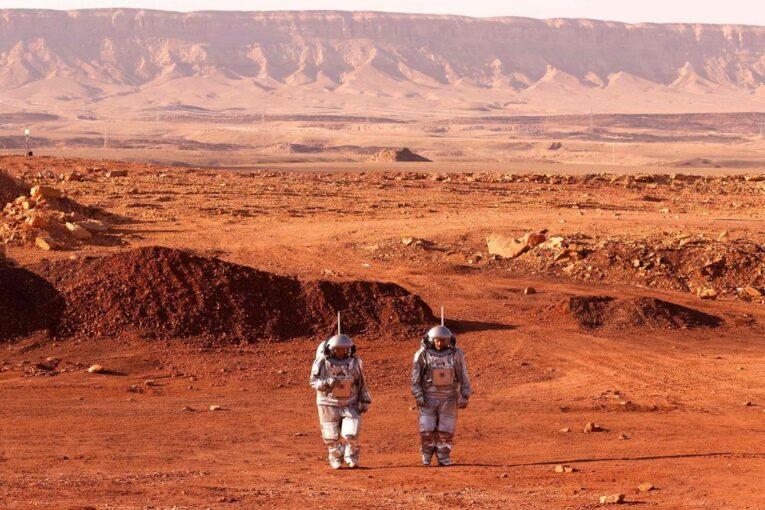
Excerpt from Chapter 1: Arrival
Imagine that today’s date is in the 2080s and you are part of the third or fourth wave of immigrants to the Red Planet. Thanks to climate change, life on Earth has become challenging for most people. Things haven’t gotten better since the ’20s, our leaders did not tackle issues with courage and so overpopulation, inequality, poverty, and water scarcity have made major metropolitan areas extremely unpleasant. The Earth, for many people, has become hot, dirty, and crowded.
But in this future, an alternative has opened up: a permanent community, BaseTown, has been established on Mars, and people are lining up for the opportunity to go. The community itself has grown to about ten thousand people and is expected to reach one hundred thousand over the next generation.
More importantly, however, is the fact that the technologies developed to sustain life on Mars have started to revolutionize life back on Earth. Cyanobacteria bred to turn the nitrogen and carbon dioxide in Mars’s atmosphere into organic molecules have been exported back to Earth. Back home, these cyanobacteria now mop up the carbon dioxide left in the Earth’s atmosphere by the industrial age and help rehabilitate degraded farmland. The way BaseTown synthesizes proteins in giant bioreactors has also been exported back to Earth to keep people healthy now that climate change has limited animal agriculture.
However, you don’t see these bacterial bioreactors when you take the transit pod from the orbital landing pad to BaseTown’s cliff-face entrance. The bioreactors don’t make much of an impression on the landscape. Really, they are nothing more than giant underground tanks fed with solar energy and carbon dioxide. Sunlight is brought down using fiber-optic cables, so most of BaseTown’s inhabitants are only faintly aware of this part of the infrastructure.
What catches your attention — what catches everyone’s attention — is the cliff face that has become a honeycomb of reinforced windows and skylights, carefully designed to withstand the possibility of a meteor strike, tinted to filter out harmful radiation, but engineered to allow in the greatest possible amount of light. When you step out of the transit shuttle and into BaseTown’s main mezzanine, you are greeted with a surprisingly open and well-lit space that is full of greenery. One of BaseTown’s abiding design principles is to ensure that every photon of solar energy that enters BaseTown is put to multiple uses. Plants are encouraged to grow in all sunlit places. And each of these plants sucks up extra carbon dioxide, emits oxygen, purifies water, and turns organic molecules into food. Plus, the plants are nice to look at: it’s hard and dangerous to take a trek out on the surface, and most people spend their time on Mars indoors. Plants outnumber people by a thousand to one.
These plants have been bred to deal with the low-gravity and lower-pressure environment and all are nestled in a hydroponic solution, but your first impression of BaseTown is that every resident must be a master gardener.
It’s been a long journey from Earth, and for months you have been eating nothing but a steady diet of freeze-dried and hyper-preserved food. So, you are eager to taste Martian cuisine. Identifying a small leafy food court, you use your new identification card and order yourself salmon sashimi, toasted seaweed, a garden salad, and then, glancing at the beverages, you opt for a milkshake.
On the menu, all these items are listed as locally sourced and when they arrive on a conveyor, you are pleasantly impressed.
The sashimi is really a cell culture that has been 3D printed to look as if it came from salmon; as you bite down on the pleasant texture, you wonder whether this technology might have prevented the Earth’s salmon from being driven to near-extinction by overfishing?
The seaweed tastes exactly like the seaweed on Earth, as does the green salad, except that this green salad is much fresher than what you are used to as it has been harvested from hydroponic beds earlier today. And as for the milkshake, the dairy proteins are the product of a specially designed fermentation process, but you have no idea whether this milkshake tastes as if it came from real cow milk because you’ve never tasted “real” dairy before. Over the past two generations, the number of cows on Earth plummeted, and today it is rare to eat real meat or dairy, and many people choose not to. Regardless, this Martian milkshake is both refreshing and rich.
After you finish this first meal on Mars, you carefully place your utensils and dishes in a sterilization chamber and meticulously scrape every scrap of organic matter off your plate and into a sophisticated composting infrastructure. The UN’s training for space pioneers was very clear on this point. On Mars, there can be no such thing as waste. Resources are scarce, and everything must be carefully stewarded. Again, perhaps this is another lesson that we should have learned ages ago on Earth.
You look around at your new home — your fresh start — and think, This might not be so bad. Maybe folks back home have something to learn from the system we’ve built up here?
You can read more of the news on source
